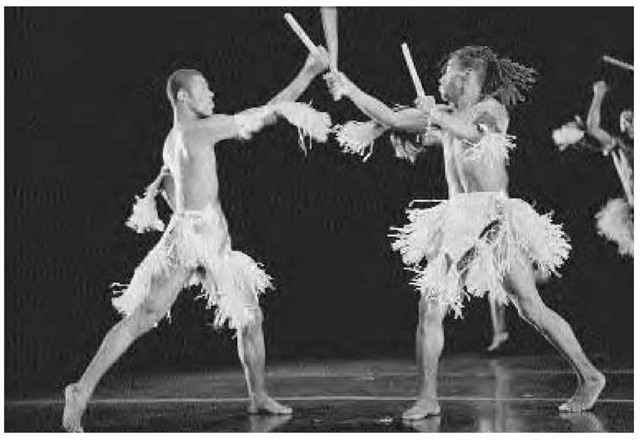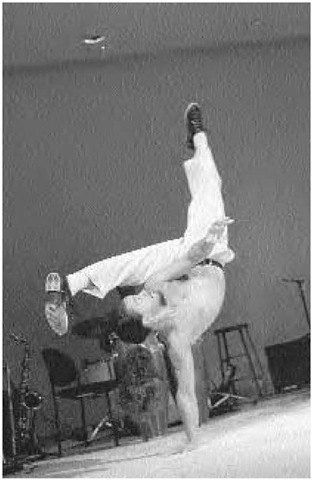Capoeira is a Brazilian martial art that relies primarily on striking techniques, although some grappling maneuvers, especially takedowns utilizing the legs in either tripping or scissoring motions, and weapon techniques complete the repertoire of the capoeirista (practitioner or “player” of capoeira). Various etymologies of the name capoeira are offered in the scholarly literature. The root ca or cad from Native Brazilian languages refers to forests or woods. This linguistic stem is often used to connect the origins of the term and the art to which it refers to African slave originators who, the oral traditions of the art maintain, escaped to or practiced in the bush from the sixteenth through the nineteenth centuries. Alternatively, the Portuguese words capao (cock) and capoeira (cage for cocks) have been used to link the word to a poultry market area in Rio de Janeiro where slaves held capoeira rodas (roda [wheel], the playing area formed by capoeiristas standing in a circle; also the contest or game played within such a circle) and to cockfighting. Neither these nor any of a multitude of other explanations for the origin of the term have been universally accepted.
The origins of capoeira are recorded only in the traditional legends of the art and invariably focus on African influence. Considerable debate exists among practitioners and historians as to whether capoeira is the New World development of an African martial art or a system originating in the New World with African influences ranging from terminology to the berimbau, the primary musical instrument used to provide accompaniment for the jogo (“match” or “game”). There are even suggestions that some of the kicking techniques are derived from French savate via European seamen who manned the cargo vessels that docked in Brazilian ports.
Regardless of the genealogy, the legends invariably associate capoeira with the slave experience, which in Brazil lasted from the beginnings of the sixteenth century until 1888. The vehicle of dance that characterizes the practice of capoeira, oral traditions argue, allowed the practice of martial techniques but concealed their intent from the overseers. Blows struck with the feet and head-butts, some argue, could be delivered by men in chains. Moreover, many oral traditions claim that the practice of capoeira allowed those slaves who escaped and survived to establish communities in the bush to defend themselves from the groups of armed men who sought to apprehend and return them to captivity.
Theatrical reproduction of the maculele dance associated with capoeira.
Written records alluding to the art date only to around the last century of the slave experience (beginning in 1770), and in them capoeira was identified, not with African Brazilians, but with a Portuguese bodyguard of the viceroy. Throughout the nineteenth century, references to capoeira identify it not with the rural settings of the folk histories but with urban centers such as Recife, Salvador, and Rio de Janeiro. The art was generally associated with the street, petty crime, and social disorder into the early decades of the twentieth century. Contemporary traditions echo this earlier disreputability. For example, it has been traditional to receive a nickname at one’s batizada (“christening,” or acceptance into the art). This harks back to the necessity of a street name among earlier capoeiristas. As one might expect with an art of the street, the traditional way to learn capoeira was by observing play, by playing, or by using it in street defense. Any instruction was extremely informal. Brazilian author Jorge Amado in his novel Jubiabd gives several accounts of capoeira as it existed on the streets of his native Bahia. These vignettes reflect both the unstructured way of acquiring knowledge of capoeira and the vicious quality of its use as a street-fighting system. The customary label for this art, Capoeira Angola, pays homage to its legendary African origins.
In the late 1920s to early 1930s, however, a new way to study capoeira became available. During that period, Manoel dos Reis Machado—Mestre (Master) Bimba—opened his school and began attempts both to legitimize the art and to systematize its transmission. The difficulties he faced are suggested by the fact that it was not until 1937 that his school, Centro de Cul-tura Fisica e Capoeira Regional, was granted official state recognition. Mestre Bimba’s system came to be known as Capoeira Regional (after his school’s name) in order to distinguish it from the traditional style still played on the streets and taught by conservative mestres—Capoeira Angola. In contrast to the earlier trial-and-error learning acquired by entering the roda, Machado developed a structured curriculum in a training hall setting. He has been accused of appropriating elements of Asian arts, particularly karate and jujutsu, into his style of capoeira. The best evidence suggests, however, that his system grew from traditional street capoeira with some influences from batuque (a rough game of kicking and tripping with obvious martial qualities) via his father. Nevertheless, the structure Machado set up is imbued with elements familiar to students of many Asian martial arts, such as formalized exercises containing series of basic movements (sequencias), uniforms consisting of white trousers and T-shirts, and colored belts indicating rank (cordaos). The cordao system is not uniform— different local clubs (grupos) use different colors to indicate rank or level of experience—nor has it been universally adopted—those organizations following the Angola tradition do not use belts, or white uniforms, at all.
Capoeira is said to be “played”; therefore, a match is labeled a jogo (a game). The jogo takes place in a ring called a roda (wheel) formed by participants waiting their turns to play. Roda is also the label used for an occasion for capoeira play, for example, “next Sunday’s roda.” The jogo is played to the musical accompaniment of percussion instruments derived in the New World from African archetypes: the berimbau (a large musical bow utilizing a gourd resonator that is played by striking its metal bowstring with a stick), the pandeiro (tambourine), the agogo (a pair of clap-perless bells struck with a metal stick), the reco-reco (a notched scraper), and the atabaque (conga drum). The berimbau is the primary instrument and is venerated by players. For example, its placement provides spatial orientation for play, in that its location is called pe do berimbau (foot of the berimbau), and players enter the roda after kneeling facing one another and performing a private ritual (e.g., making the sign of the cross) in front of the berimbau. Thus, the instrument creates a “sacred space” in the roda.
An acrobatic kick from a one-handed handstand, a signature move of capoeira, November 14, 1996.
Songs involving a leader-and-response pattern are sung during play. The words of these songs embody, to take a few examples, comments on capoeira in general, insults directed toward various types of styles of play or types of players, and biographical allusions to famous capoeiristas. The sense of capoeira as a dance is established by this musical frame for the action and completed by the movements taking place within the roda. The basic stance of capoeira places one foot forward in a lunging move with the corresponding hand forward and the other hand back. There is, however, considerable variety in the execution of the stance (both between individual players and between the Regional and the Angola traditions), and stances rapidly shift, with feet alternating in time to the tempo of the musical accompaniment in a dancelike action called a ginga. The techniques of capoeira rely heavily on kicks, many of them embodied in spectacular cartwheels, somersaults, and handstands. Players move from aerial techniques to low squatting postures accompanied by sweeps or tripping moves. Evasion rather than blocking is used for defense. Head-butts and hand strikes (using the open hand) complete the unarmed arsenal of the capoeirista. Again, there is a distinction between Angola and Regional, with the former relying more on low kicks, sweeps, and trips, played to a slower rhythm.
As an armed fighting art, capoeira has incorporated techniques for the use of paired short sticks and bladed weapons (particularly straight razors, knives, and machetes). Even in those cases in which the art has moved from the streets to the training hall, training in weapons remains in the curriculum in forms such as maculele, which entails a rhythmic clash of short sticks while performing a dancelike action.
In the 1970s capoeira spread to the United States. Mestres Jelon Viera and Loremil Machado brought the art to New York in 1975, and by 1979 Bira Almeida began teaching in California. Other mestres from both major traditions followed suit—for example Mestre Cobra Mansa (Cinezio Feli-ciano Pecanha) of the International Capoeira Angola Foundation in Washington, D.C., who visited and eventually moved to the United States in the early 1990s. By the late 1990s capoeira had developed an international following. The popularity of the art has been fostered by its inclusion in Hollywood films such as The Quest, Mortal Kombat II, and especially Only the Strong, with its capoeira mestre protagonist. Capoeira has even appeared recently in video game formats, played, for example, by the character of Eddie Gordo in “Tekken III.”


